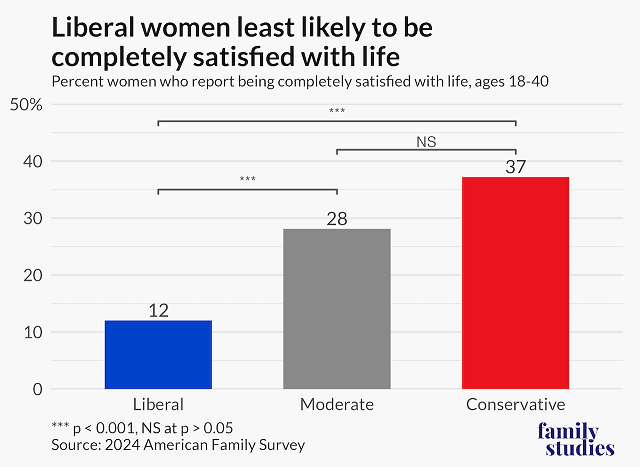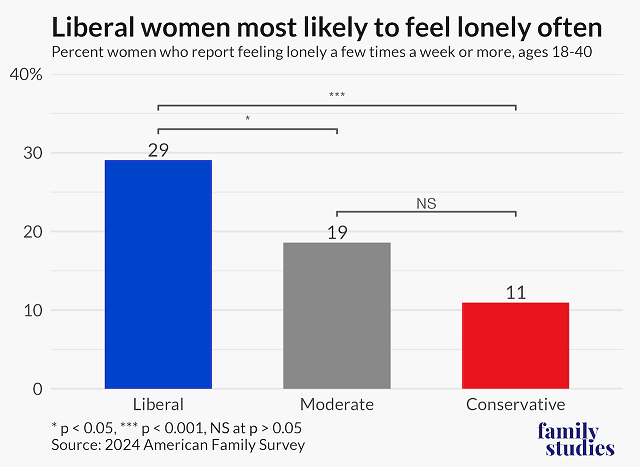Highlights
- Young conservative women are three times as likely to report being very satisfied with life compared to young liberal women. Post This
- These two factors, church and marriage, account for about half the ideological gap among young women in a multivariate analysis of life satisfaction that included controls for factors like race, education, and income. Post This
- Liberal young women are less likely to be integrated into core American institutions—marriage and religion—that lend meaning, direction, and a sense of solidarity to women’s lives. Post This
Young liberal women are especially prone nowadays to reporting poor mental health. This was the discovery that Zach Goldberg made almost five years ago pouring over Pew data in the spring of 2020. Further research in 2022 found that depression had surged among liberal high school girls in the last decade-and-a-half, and much more so for them than other high schoolers, especially conservatives.
Is this ideological gap in the mental health of liberal and conservative women still present?
Yes, new evidence from 2024 American Family Survey indicates it is. Young liberal women are markedly less satisfied with life than their conservative peers. Specifically, we found that 37% of conservative women reported being “completely satisfied” with life, whereas only 12% of liberal women did. Young conservative women are three times as likely to report being very satisfied with life compared to young liberal women. Moreover, liberal women are two to three times more likely to report they are “not satisfied” with their lives, compared to conservative women. And consistent with previous research, the effect of ideology on young women’s happiness held up to controls for age, education, race, and income.

Many of the most thoughtful interpreters—like Jonathan Haidt, Jean Twenge, and Matthew Yglesias—of this ideological divide in the emotional well-being of young women have pointed to the role that “catastrophizing” thinking has played in dragging down the spirits of liberal women. The idea is that taking an overly negative view of the world, and minimizing your own agency to navigate life, often inspired by social media, has taken a serious toll on young liberal women’s emotional health. That’s because, as Yglesias put it: “Mentally processing ambiguous events with a negative spin is just what depression is.”
We don’t doubt the power of technologically-induced negative thinking in driving down liberal young women’s spirits, especially because they use social media more than their conservative female peers, as Twenge noted. But we think there is more to the story. Given that we’re “social animals,” as Aristotle noted, we think different levels of “social integration” between liberal and conservative young women also may have a hand in the happiness divide between the two groups.
Our thinking here is indebted to the great French sociologist, Emile Durkheim, who stressed the value of social integration into core social institutions for the emotional welfare of men and women. So, we looked at how marriage, churchgoing, and loneliness help to account for the happiness gap between liberal and conservative women.
Our results from the American Family Survey are striking. Conservative women ages 18-40 are married at rates that are 20 percentage points than liberal women in the same age group. And whereas over half of conservative women in this age group attend church weekly, only 12% of their liberal peers do. Together, these two factors account for about half the ideological gap among young women in a multivariate analysis of life satisfaction that included controls for factors like race, education, and income.

We also looked at loneliness, which unfortunately has been on the rise for Americans. But we found that liberal women ages 18 to 40 are much more likely to report frequent feelings of loneliness. Nearly one-in-three (29%) reported feeling lonely a few times a week or more. Conservative women, on the other hand, are much less likely to report feeling lonely, with just 11% feeling lonely a few times a week or more. Unsurprisingly, loneliness is correlated with life satisfaction. When we included loneliness in our life satisfaction model, it diminished the effect of marriage and church attendance. Even still, marriage was a strong predictor of life satisfaction.
When we control for education, race, age, and income, the 2024 American Family Survey data also indicate that liberal women ages 18 to 40 are over three times as likely to report frequent feelings of loneliness compared to their conservative peers. But a large part of this loneliness gap comes from different rates of marriage and church attendance, seen in the table above. Adding controls for marriage and church attendance, ideology becomes less important, with marriage being the strongest predictor of feeling less lonely.

Taken together, our analysis leads us to three conclusions.
First, the ideological divide in emotional well-being between young liberal and conservative women endures.
Second, this ideological divide does not appear to be just a consequence of negative thinking; it also seems to flow from the fact that liberal young women are less likely to be integrated into core American institutions—specifically marriage and religion—that lend meaning, direction, and a sense of solidarity to women’s lives.
Third, lower levels of marriage and churchgoing among liberal women may also have a hand in their elevated reports of loneliness, which, in turn, diminishes their odds of being happy.
The bottom line, then, is that any efforts to bridge this ideological gap in young women’s emotional well-being will seemingly require not only a change in thinking but also a renewal of young liberal women’s connection to America’s core institutions—family and faith.
Grant Bailey is a Research Associate of the Institute for Family Studies. Brad Wilcox is a Senior Fellow of the Institute for Family Studies.














